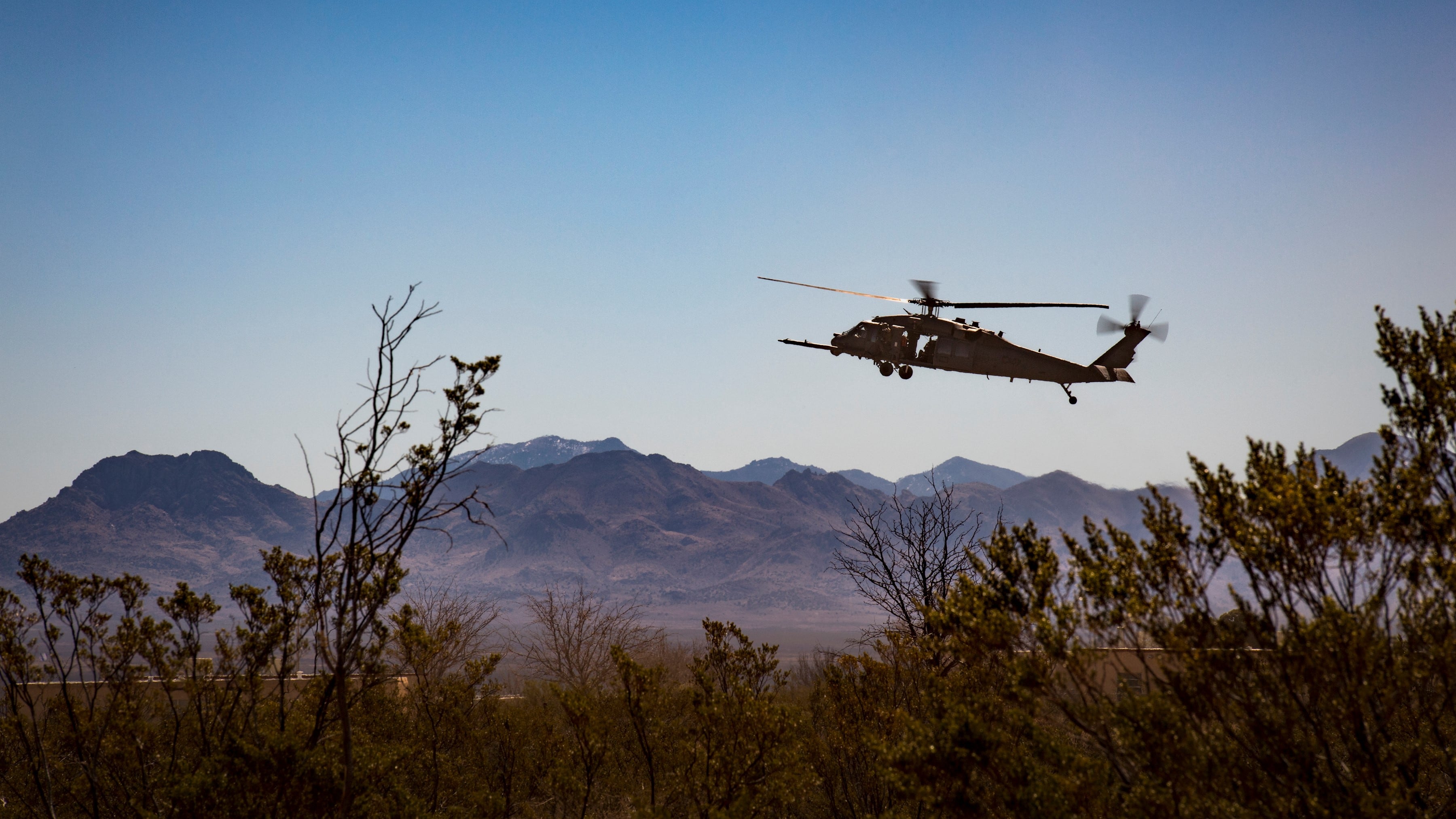WASHINGTON — The Defense Department will focus on preventing interference to aviation instruments rather than trying to stop the Federal Communications Commission from auctioning C-band spectrum used for 5G communication, officials tell Defense News.
The Pentagon’s decision comes despite industry’s concerns about the functionality of a key aviation technology, which led to a Dec. 1 memo from the head of the Federal Aviation Administration and the number two at the Department of Transportation requesting the FCC pause the sale. The letter was sent after an aviation trade group found that 5G operations could cause harmful interference to radar altimeters, which are used by civil, military and commercial airplanes and helicopters to measure the distance between the aircraft and the ground.
But rather than push back at the FCC, Pentagon officials believe their energies are best spent focused on studying how the deployment of 5G networks throughout U.S. metropolitan areas will impact military aircraft and putting in place a strategy to mitigate any safety concerns, said Alan Burke, the Pentagon’s chair for the interagency Aviation Cyber Initiative Task Force.
“The approach should be not on trying to slow down 5G metro deployment, but speeding up development and testing of mitigations that can serve as an interim gap until avionics manufacturers can harden their systems,” Burke said during a Jan. 7 interview.
RELATED

“The longer-term challenge is going to be making — not just radar altimeters — but avionics systems that are resilient to out-of-band interference, understanding what that interference is and what mitigations are required.”
As part of the Trump administration’s 5G FAST Plan, the FCC hopes to sell more than 5,000 new flexible-use overlay licenses for C-band spectrum in the 3.7–3.98 GHz frequency. The first phase of the auction, which ran from Dec. 8 to Jan. 15, received bids totaling $80.9 billion and has been billed as the highest-grossing auction of its kind in U.S. history.
“The FCC confronted a host of technical, legal, practical, and political challenges in structuring this auction,” outgoing FCC chairman Ajit Pai said in a statement. “It would have been easy to delay. But we rightly pushed ahead and overcame every one of those obstacles. As a result, we significantly advanced United States leadership in 5G and have enabled America’s wireless consumers to more quickly benefit from 5G services.”
But testing has shown that 5G activities in the 3.7-3.98 portion of the band could create “harmful interference” for radar altimeters, which operate in the neighboring 4.2-4.4 GHz portion of the band, according to an October study by RTCA, a trade organization that works with the FAA to develop safety standards.
Although RTCA looked only at radar altimeters on commercial and civil aircraft, military aircraft altimeters operate on the same part of the spectrum and could be similarly vulnerable to interference, Burke said.
Defense Department officials including Burke met with leaders from the FAA, Department of Homeland Security and other stakeholder agencies on Dec. 21 to discuss the issue.
During the meeting, defense officials said representatives from Honeywell — a top supplier of radar altimeters and one of the companies who conducted research for the RTCA report — presented their findings and recommended that further testing be done for military radar altimeters. Honeywell declined to comment for this story.
The immediate problem, Burke said, is that the Defense Department does not yet have a test range capable of evaluating how 5G telecommunications impact military-specific avionic equipment like radar altimeters.
“We’re working to establish a collaborative interagency approach,” Burke said. “And that includes [establishing] a national 5G operational test range. If we wanted to do operational testing of our radar altimeters in a 5G C band environment, we don’t have the capability to do that right now. And so that’s a shortfall that we want to work to address.”
The Pentagon sees that testing as an important bargaining chip for future discussions with the FCC, which has rejected the findings of the RTCA study as being overly stringent and not representative of operational scenarios.
“If we want to improve on our ability to negotiate with the FCC, we have to back it up with facts — facts based on operational testing. I think the operational testing component is very important to improve our ability to make our case,” Burke said. “Simulations aren’t adequate.”

The road ahead
Several organizations are already building 5G test capabilities that could allow the Pentagon to do some level of assessment, including Hill Air Force Base in Utah, Idaho National Laboratory and the University of Utah.
Defense Department leaders hope to work with officials across the government to “identify what effort has the best chance of success” of supporting operational testing. The department would then have to divert funding to speed up the establishment of the range to and to conduct test activities, with the hope of completing an initial assessment in 12 to 18 months, Burke said.
Military aviation officials have told Defense News that the operations of cargo planes and aerial refueling tankers would be the most impacted by 5G interference. Certain mobility planes are approved to make landings during “instrument landing conditions,” or weather scenarios where there is poor visibility and a pilot has to rely on instruments like the radar altimeter instead of visual cues.
But if an aircraft’s altimeter is not working due to interference, that pilot would likely have to land elsewhere.
Most military radar altimeters have built-in protections for high powered microwave and high intensity radiation frequencies, but right now the aviation community does not understand whether those defenses might safeguard against 5G interference, Burke said.
Once the department understands the operational impact of 5G on its aircraft, it may have to take steps to address aviation safety concerns.
Currently, the Pentagon is not discussing the wholesale replacement of its radar altimeters or the movement of devices to another portion of the electromagnetic spectrum, said Burke and Col. Ken Miller, who commands the Air Force Spectrum Management Office.
Instead, the department is looking at options such as designating “airfield operational exclusion zones” that block out 5G interference near airports in metropolitan areas, where interference would be the most dense and potentially harmful.
Another mitigation approach is the use of filters to harden radar altimeters against interference.
“Radar altimeters already have certain filters on them,” Burke said. “It’s unknown how effective they would be at filtering this interference. We haven’t really gone too far down the technical lane here, but we do know that those kind of things are possible.”
However, another senior government official pointed out that such measures could reduce the accuracy of the altimeter.
“If you have a very high precision radar altimeter that’s looking at a very wide bandwidth and has no filter, and you’ve got to add a filter, that adds size, weight [and] power requirements and reduces performance,” the source said.
Further out, the Defense Department will likely need to introduce new industrial standards so that future radar altimeter designs are more tolerant of interference that occurs due to devices operating on a neighboring portion of the electromagnetic spectrum — a situation that is becoming more prevalent with the rise of 5G.
“The paradigm in general is we test the devices to make sure that they’re transmitting in their assigned bands and operating in their assigned bands. What we normally haven’t been testing for is what we call out-of-band interference,” Burke said.
“People are going to have to adapt to that. On the spectrum highway, we want to be able to use all the lanes, and people can’t be bandwidth hogs because of their device designs. They’re going to have to relook at the design of devices to be more spectrum resilient.”
Valerie Insinna is Defense News' air warfare reporter. She previously worked the Navy/congressional beats for Defense Daily, which followed almost three years as a staff writer for National Defense Magazine. Prior to that, she worked as an editorial assistant for the Tokyo Shimbun’s Washington bureau.
Aaron Mehta was deputy editor and senior Pentagon correspondent for Defense News, covering policy, strategy and acquisition at the highest levels of the Defense Department and its international partners.








